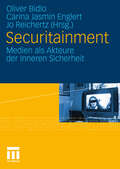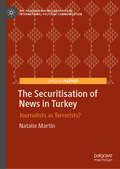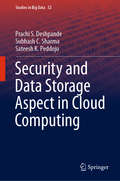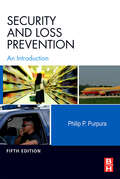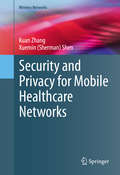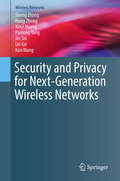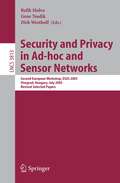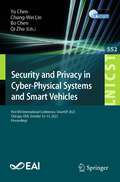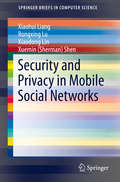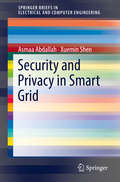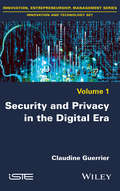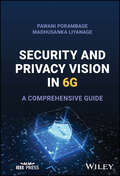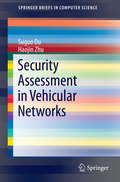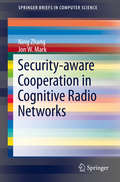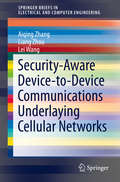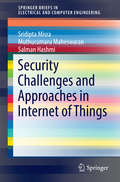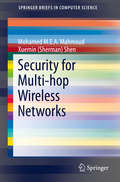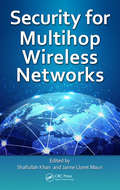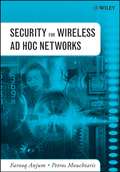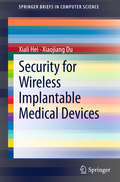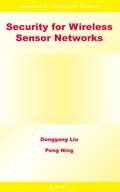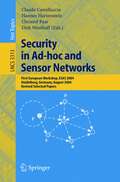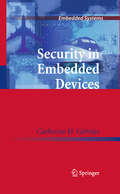- Table View
- List View
Securitainment: Medien als Akteure der Inneren Sicherheit
by Oliver Bidlo Carina Englert Jo ReichertzFernsehen, Zeitung und Internet berichten nicht mehr nur über die Welt, sondern sie beteiligen sich mittlerweile (die einen mehr, die anderen weniger) aktiv am gesellschaftlichen Diskurs über die richtige (Sicherheits-) Politik. Dies tun sie, indem sie bestimmte Themen auf die Agenda setzen, Entscheidungen kommentieren oder Deutungsrahmen liefern. Darüber hinaus, und das ist das Thema des Buches, werden sie aus wirtschaftlichen Gründen immer mehr zu eigenständigen Akteuren, die on air und off air explizit die Politik der Inneren Sicherheit mitgestalten. On air ‚verpacken’ sie das Thema Innere Sicherheit in unterhaltende Formate. Die Botschaft fast all dieser Formate des Reality-TV: Aktivierung und Selbstführung der Bürger.
The Securitisation of News in Turkey: Journalists as Terrorists? (The Palgrave Macmillan Series in International Political Communication)
by Natalie MartinThis book examines why Turkey has become infamous as a repressor of news media freedom. For the past decade or so it has stood alongside China as a notorious jailer of journalists – at the same time as being a candidate state of the EU. The author argues that the reasons for this conundrum are complex and whilst the AKP is responsible for the most recent illiberality, its actions should be taken in the wider context of Turkish politics – and the three way battle for power which has been raging between Kemalists, Kurds and Islamists since the republic was founded in 1923. The AKP are the current winners of this tripartite power struggle and the securitisation of journalists as terrorists is part of that quest. Moreover, whilst securitisation is not new, it has intensified recently as the number of the AKP’s political opponents has proliferated. Securitisation is also a means of delegitimising journalism – and neutralizing any threat to the AKP’s electoral prospects – whilst maintaining a democratic façade on the world stage. Lastly, the book argues that whilst the AKP’s securitisation of news began as a means of quashing the reporting of illiberality against wider political targets, since 2016 it has become a target in its own right. In the battle for power in Turkey, journalism is now one of the many losers.
Security and Data Storage Aspect in Cloud Computing (Studies in Big Data #52)
by Prachi S. Deshpande Subhash C. Sharma Sateesh K. PeddojuThis book analyses the various security threats in cloud computing. A host-based IDS (HIDS) using signature verification is developed and implemented for the concerned security issues. Further, owing to the vulnerability of distributed denial of service (DDoS) attacks in cloud computing, a network based IDS (NIDS) is developed and implemented against such attacks. The performance of these IDS is verified in the Cloud scenario as well against the standard data set. Finally, a simple data storage and security model is developed and implemented for the Cloud computing scenario. The contents of this book will be of interest to researchers and professionals alike.
Security and Loss Prevention: An Introduction
by Philip PurpuraSecurity and Loss Prevention, Fifth Edition, encompasses the breadth and depth of considerations involved in implementing general loss prevention concepts and security programs within an organization. It presents proven strategies to prevent and reduce incidents of loss due to legal issues, theft and other crimes, fire, accidental or intentional harm from employees as well as the many ramifications of corporate mismanagement. It contains a brand new terrorism chapter, along with coverage on background investigations, protection of sensitive information, internal threats, and considerations at select facilities (nuclear, DoD, government and federal). Author Philip Purpura once again demonstrates why students and professionals alike rely on this best-selling text as a timely, reliable resource. This book is an ideal resource for criminal justice and security academic programs, physical security professionals, retail security professionals, security managers, security consultants, law enforcement professionals, investigations professionals, risk and contingency planning professionals.- Covers the latest professional security issues surrounding Homeland Security and risks presented by threats of terrorism- Recommended reading for ASIS International's prestigious CPP Certification- Cases provide real-world applications
Security and Privacy for Mobile Healthcare Networks (Wireless Networks)
by Kuan Zhang Xuemin (Sherman) ShenThis book examines state-of-art research on designing healthcare applications with the consideration of security and privacy. It explains the Mobile Healthcare Network (MHN) architecture and its diverse applications, and reviews the existing works on security and privacy for MHNs. Critical future challenges and research problems are also identified. Using a Quality-of-Protection perspective, the authors provide valuable insights on security and privacy preservation for MHNs. Some promising solutions are proposed to accommodate the issues of secure health data transmission, misbehavior detection, health data processing with privacy preservation and access control in MHNs. Specifically, the secure health data aggregation explores social spots to help forward health data and enable users to select the optimal relay according to their social ties and health data priority. The secure aggregation achieves the desirable delivery ratio with reasonable communication costs and lower delay for the data in different priorities. A proposed misbehavior detection scheme distinguishes Sybil attackers from normal users by comparing their mobile contacts and pseudonym changing behaviors. The detection accuracy is high enough to resist various Sybil attacks including forgery. In addition, the health data processing scheme can analyze the encrypted health data and preserve user’s privacy at the same time. Attribute based access control can achieve fine-grained access control with user-defined access policy in MHNs. Security and Privacy for Mobile Healthcare Networks is designed for researchers and advanced-level students interested in healthcare security and secure data transmission.
Security and Privacy for Next-Generation Wireless Networks (Wireless Networks)
by Sheng Zhong Hong Zhong Xinyi Huang Panlong Yang Jin Shi Lei Xie Kun WangThis timely book provides broad coverage of security and privacy issues in the macro and micro perspective. In macroperspective, the system and algorithm fundamentals of next-generation wireless networks are discussed. In micro-perspective, this book focuses on the key secure and privacy techniques in different emerging networks from the interconnection view of human and cyber-physical world. This book includes 7 chapters from prominent international researchers working in this subject area. This book serves as a useful reference for researchers, graduate students, and practitioners seeking solutions to wireless security and privacy related issues Recent advances in wireless communication technologies have enabled the large-scale deployment of next-generation wireless networks, and many other wireless applications are emerging. The next generation of mobile networks continues to transform the way people communicate and access information. As a matter of fact, next-generation emerging networks are exploiting their numerous applications in both military and civil fields. For most applications, it is important to guarantee high security of the deployed network in order to defend against attacks from adversaries, as well as the privacy intrusion. The key target in the development of next-generation wireless networks is to promote the integration of the human, cyber, and physical worlds. Previous work in Cyber Physical Systems (CPS) considered the connection between the cyber world and the physical world. In the recent studies, human involvement brings new channels and initiatives in this interconnection. In this integration process, security and privacy are critical issues to many wireless network applications, and it is a paramount concern for the growth of next-generation wireless networks. This is due to the open nature of wireless communication and the involvement of humans. New opportunities for tackling these security and privacy issues in next-generation wireless networks will be achieved by leveraging the properties of interaction among human, computers and things.
Security and Privacy in Ad-hoc and Sensor Networks: Second European Workshop, ESAS 2005, Visegrad, Hungary, July 13-14, 2005. Revised Selected Papers (Lecture Notes in Computer Science #3813)
by Refik Molva Gene Tsudik Dirk WesthoffIt was a pleasure to take part in the 2005 European Workshop on Security and Privacy in Ad Hoc and Sensor Networks (ESAS 2005), held on July 13–14 in Visegrad (Hungary) in conjunction with the First International Conference on Wireless Internet (WICON) . As Program Co-chairs, we are very happy with the outcome of this year’s ESAS workshop. It clearly demonstrates the continued importance, popularity andtimeliness oftheworkshop’stopic: securityandprivacy inadhocandsensor networks.Atotalof51fullpapersweresubmitted.Eachsubmissionwasreviewed by at least three expert referees. After a short period of intense discussions and deliberations, the Program Committee selected 17 papers for presentation and subsequent publication in the workshop proceedings. This corresponds to an acceptance rate of 33% — a respectable rate by any measure. First and foremost, we thank the authors of ALL submitted papers. Your con?dence in this venue is much appreciated. We hope that you will continue patronizing ESAS as authors and attendees. We are also very grateful to our colleagues in the research community who served on the ESAS Program C- mittee. Your sel?ess dedication is what makes the workshop a success. Finally, we are very grateful to the ESAS Steering Group: Levente Buttyan, Claude Castelluccia, Dirk Westho? and Susanne Wetzel. They had the vision and the drive to create this workshopin the ?rst place; they also provided many insightsandlotsofhelpwiththisyear’sevent.Weespeciallyacknowledgeand- preciate the work of Levente Buttyan whose dedication (as Steering Committee member, PC member and Local Arrangements Chair) played a very important role in the success of the workshop.
Security and Privacy in Cyber-Physical Systems and Smart Vehicles: First EAI International Conference, SmartSP 2023, Chicago, USA, October 12-13, 2023, Proceedings (Lecture Notes of the Institute for Computer Sciences, Social Informatics and Telecommunications Engineering #552)
by Yu Chen Chung-Wei Lin Bo Chen Qi ZhuThis book constitutes the refereed proceedings of the First EAI International Conference, SmartSP 2023, held in Chicago, USA, during October 12-13, 2023. The 11 revised full papers were carefully reviewed and selected from 24 submissions. The papers focus on all details all technological aspects that are relevant to Security and privacy in cyber-physical systems.
Security and Privacy in Mobile Social Networks (SpringerBriefs in Computer Science)
by Xiaohui Liang Rongxing Lu Xiaodong Lin Xuemin ShenThis book focuses on three emerging research topics in mobile social networks (MSNs): privacy-preserving profile matching (PPM) protocols, privacy-preserving cooperative data forwarding (PDF) protocols, and trustworthy service evaluation (TSE) systems. The PPM helps two users compare their personal profiles without disclosing the profiles. The PDF helps users forward data to their friends via multiple cooperative relay peers while preserving their identity and location privacy. The TSE enables users to locally share service reviews on the vendors such that users receive more valuable information about the services not only from vendors but also from their trusted social friends. The authors address both theoretic and practical aspects of these topics by introducing the system model, reviewing the related works, and presenting the solutions. Security and Privacy for Mobile Social Networks further provides the security analysis and the performance evaluation based on real-trace simulations. It also summarizes the future research directions for this rapidly growing area of research. The book will be valuable for researchers and practitioners who work with mobile social networks, communication platforms, wireless communication techniques, and internet applications."Suitable for any type of reader as an introduction to the topic... The chapters are well motivated and presented... It is recommended for researchers." -ACM Computing Reviews, 21 July 2014
Security and Privacy in Smart Grid (SpringerBriefs in Electrical and Computer Engineering)
by Asmaa Abdallah Xuemin ShenThis SpringerBrief addresses the main security concerns for smart grid, e.g., the privacy of electricity consumers, the exchanged messages integrity and confidentiality, the authenticity of participated parties, and the false data injection attacks. Moreover, the authors demonstrate in detail the various proposed techniques to secure the smart grid’s different communication networks and preserve the privacy of the involved. Over many years, power grid has generated electricity from central generators and distributed it in one direction from the generation stations to end-users; also, information is one directional so that the grid’s control center doesn’t get enough information about customers’ requirements and consequently can’t prevent electricity losses. So, the electricity grid is merged with information and communication technology to form smart grid. The main target of this incorporation is to connect different parties of power grid to exchange information about grid conditions and customers’ requirements, and consequently, improve the reliability and efficiency of electricity generation and distribution. That upgrade of the power grid exposes it to the cyber security threats that the communication networks suffer from, such as malicious attacks to forge the electricity consumption readings or price, extract personal information for residential consumers, such as daily habits and life style, or attack some grid’s resources and equipment availability using denial-of-service attacks. Also, novel threats are introduced in smart grid due to the power grid nature, such as false data injection attack, in which the adversary compromises several measurement units and injects false information about the grid conditions that mislead the grid’s control center to make wrong decisions for the grid and consequently impact on its stability and efficiency.
Security and Privacy in the Digital Era
by Claudine Guerrier"The state, that must eradicate all feelings of insecurity, even potential ones, has been caught in a spiral of exception, suspicion and oppression that may lead to a complete disappearance of liberties."—Mireille Delmas Marty, Libertés et sûreté dans un monde dangereux, 2010 This book will examine the security/freedom duo in space and time with regards to electronic communications and technologies used in social control. It will follow a diachronic path from the relative balance between philosophy and human rights, very dear to Western civilization (at the end of the 20th Century), to the current situation, where there seems to be less freedom in terms of security to the point that some scholars have wondered whether privacy should be redefined in this era. The actors involved (the Western states, digital firms, human rights organizations etc.) have seen their roles impact the legal and political science fields.
Security and Privacy in the Digital Era
by Claudine Guerrier"The state, that must eradicate all feelings of insecurity, even potential ones, has been caught in a spiral of exception, suspicion and oppression that may lead to a complete disappearance of liberties."—Mireille Delmas Marty, Libertés et sûreté dans un monde dangereux, 2010 This book will examine the security/freedom duo in space and time with regards to electronic communications and technologies used in social control. It will follow a diachronic path from the relative balance between philosophy and human rights, very dear to Western civilization (at the end of the 20th Century), to the current situation, where there seems to be less freedom in terms of security to the point that some scholars have wondered whether privacy should be redefined in this era. The actors involved (the Western states, digital firms, human rights organizations etc.) have seen their roles impact the legal and political science fields.
Security and Privacy Vision in 6G: A Comprehensive Guide
by Pawani Porambage Madhusanka LiyanageSECURITY AND PRIVACY VISION IN 6G Prepare for the future of mobile communication with this comprehensive study 6G is the next frontier in mobile communication, with development of 6G standards slated to begin as early as 2026. As telecommunications networks become faster and more intelligent, security and privacy concerns are critical. In an increasingly connected world, there is an urgent need for user data to be safeguarded and system security enhanced against a new generation of threats. Security and Privacy Vision in 6G provides a comprehensive survey of these threats and the emerging techniques for safeguarding against them. It includes mechanisms for prediction, detection, mitigation, and prevention, such that threats to privacy and security can be forestalled at any stage. Fully engaged with proposed 6G architectures, it is an essential resource for mobile communications professionals looking for a head start on the technology of the future. Security and Privacy Vision in 6G readers will also find: Detailed coverage of topics including edge intelligence and cloudification, industrial automation, collaborative robots, and more Treatment balancing the practical and the theoretical An editorial team with decades of international network technology experience in both industry and academia Security and Privacy Vision in 6G is a vital reference for network security professionals and for postgraduate and advanced undergraduate students in mobile communications and network security-related fields.
Security and Privacy Vision in 6G: A Comprehensive Guide
by Pawani Porambage Madhusanka LiyanageSECURITY AND PRIVACY VISION IN 6G Prepare for the future of mobile communication with this comprehensive study 6G is the next frontier in mobile communication, with development of 6G standards slated to begin as early as 2026. As telecommunications networks become faster and more intelligent, security and privacy concerns are critical. In an increasingly connected world, there is an urgent need for user data to be safeguarded and system security enhanced against a new generation of threats. Security and Privacy Vision in 6G provides a comprehensive survey of these threats and the emerging techniques for safeguarding against them. It includes mechanisms for prediction, detection, mitigation, and prevention, such that threats to privacy and security can be forestalled at any stage. Fully engaged with proposed 6G architectures, it is an essential resource for mobile communications professionals looking for a head start on the technology of the future. Security and Privacy Vision in 6G readers will also find: Detailed coverage of topics including edge intelligence and cloudification, industrial automation, collaborative robots, and more Treatment balancing the practical and the theoretical An editorial team with decades of international network technology experience in both industry and academia Security and Privacy Vision in 6G is a vital reference for network security professionals and for postgraduate and advanced undergraduate students in mobile communications and network security-related fields.
Security Assessment in Vehicular Networks (SpringerBriefs in Computer Science)
by Suguo Du Haojin ZhuThis book presents several novel approaches to model the interaction between the attacker and the defender and assess the security of Vehicular Ad Hoc Networks (VANETs). The first security assessment approach is based on the attack tree security assessment model, which leverages tree based methods to analyze the risk of the system and identify the possible attacking strategies the adversaries may launch. To further capture the interaction between the attacker and the defender, the authors propose to utilize the attack-defense tree model to express the potential countermeasures which could mitigate the system. By considering rational participants that aim to maximize their payoff function, the brief describes a game-theoretic analysis approach to investigate the possible strategies that the security administrator and the attacker could adopt. A phased attack-defense game allows the reader to model the interactions between the attacker and defender for VANET security assessment. The brief offers a variety of methods for assessing the security of wireless networks. Professionals and researchers working on the defense of VANETs will find this material valuable.
Security-aware Cooperation in Cognitive Radio Networks (SpringerBriefs in Computer Science)
by Ning Zhang Jon W. MarkThis brief investigates spectrum efficient and energy efficient strategies, known as cognitive radio networks (CRNs), to ensure secure cooperation between licensed and unlicensed users. The authors address issues of spectrum scarcity, spectrum sensing, transmission performance, trust-aware cooperation, and secure communications. Two security-aware cooperation based spectrum access schemes are presented. The first is a trust-aware cooperative framework for CRNs to improve the throughput or energy efficiency of licensed users and offer transmission opportunities to unlicensed users, taking into consideration the trustworthiness of unlicensed users. The second scheme is a cooperative framework to enhance secure communications of licensed users. An introduction to CRNs and literature survey enhance the discussion while numerical results are provided to demonstrate the viability of the proposed schemes. The brief is designed for researchers and professionals working with cognitive radio networks or interested in cooperation based access. Advanced-level students studying computer communication networks and communications engineering will also find this brief useful.
Security-Aware Device-to-Device Communications Underlaying Cellular Networks (SpringerBriefs in Electrical and Computer Engineering)
by Aiqing Zhang Liang Zhou Lei WangThe objective of this SpringerBrief is to present security architectures and incentive mechanisms to realize system availability for D2D communications. D2D communications enable devices to communicate directly, improving resource utilization, enhancing user’s throughput, extending battery lifetime, etc. However, due to the open nature of D2D communications, there are two substantial technical challenges when applied to large-scale applications, that is, security and availability which is demonstrated in this book.This SpringerBrief proposes a secure data sharing protocol, which merges the advantages of public key cryptography and symmetric encryption, to achieve data security in D2D communications. Furthermore, a joint framework involving both the physical and application layer security technologies is proposed for multimedia service over D2D communications thus the scalable security service can be achieved without changing the current communication framework. Additionally, as the system availability largely depends on the cooperation degree of the users, a graph-theory based cooperative content dissemination scheme is proposed to achieve maximal Quality of Experience (QoE) with fairness and efficiency.This SpringerBrief will be a valuable resource for advanced-level students and researchers who want to learn more about cellular networks.
Security Challenges and Approaches in Internet of Things (SpringerBriefs in Electrical and Computer Engineering)
by Sridipta Misra Muthucumaru Maheswaran Salman HashmiThis book provides a comprehensive survey of the security and privacy research advancements in Internet of Things (IoT). The book lays the context for the discussion by introducing a system model for IoT. Since IoT is very varied and has been introduced in many different contexts, the system model introduced plays a crucial role in integrating the concepts into a coherent framework. After the system model, the book introduces the vulnerable features of the IoT. By providing a comprehensive discussion of the vulnerable features, the book highlights the problem areas of IoT that should be studied concerning security and privacy. Using the vulnerable features as a motivation, the book presents a vast survey of existing security and privacy approaches for IoT. The survey is a good way for the reader to pick up interesting directions of research that have already been explored and also hints at directions that could take additional investigation. Finally, the book presents four case studies that provide a detailed view of how some of the security and privacy concerns are addressed in specific problem areas.
Security for Multi-hop Wireless Networks (SpringerBriefs in Computer Science)
by Mohamed M. Mahmoud Xuemin (Sherman) ShenThis Springer Brief discusses efficient security protocols and schemes for multi-hop wireless networks. It presents an overview of security requirements for these networks, explores challenges in securing networks and presents system models. The authors introduce mechanisms to reduce the overhead and identify malicious nodes that drop packets intentionally. Also included is a new, efficient cooperation incentive scheme to stimulate the selfish nodes to relay information packets and enforce fairness. Many examples are provided, along with predictions for future directions of the field. Security for Multi-hop Wireless Networks demonstrates recent research that enhances the efficiency and safety of these key networks. Concise and practical, it is a useful tool for researchers and professionals working in network security. It is also a valuable resource for advanced-level students interested in wireless communications and networking.
Security for Multihop Wireless Networks
Security for Multihop Wireless Networks provides broad coverage of the security issues facing multihop wireless networks. Presenting the work of a different group of expert contributors in each chapter, it explores security in mobile ad hoc networks, wireless sensor networks, wireless mesh networks, and personal area networks.Detailing technologies
Security for Wireless Ad Hoc Networks
by Farooq Anjum Petros MouchtarisThis book addresses the problems and brings solutions to the security issues of ad-hoc networks. Topics included are threat attacks and vulnerabilities, basic cryptography mechanisms, authentication, secure routing, firewalls, security policy management, and future developments. An Instructor Support FTP site is available from the Wiley editorial board.
Security for Wireless Implantable Medical Devices (SpringerBriefs in Computer Science)
by Xiali Hei Xiaojiang DuIn the treatment of chronic diseases, wireless Implantable Medical Devices (IMDs) are commonly used to communicate with an outside programmer (reader). Such communication raises serious security concerns, such as the ability for hackers to gain access to a patient’s medical records. This brief provides an overview of such attacks and the new security challenges, defenses, design issues, modeling and performance evaluation in wireless IMDs. While studying the vulnerabilities of IMDs and corresponding security defenses, the reader will also learn the methodologies and tools for designing security schemes, modeling, security analysis, and performance evaluation, thus keeping pace with quickly-evolving wireless security research.
Security for Wireless Sensor Networks (Advances in Information Security #28)
by Donggang Liu Peng NingThis book discusses fundamental security issues in wireless sensor networks, techniques for the protection of such networks, as well as results from recent studies in wireless sensor network security. It contains example applications for target tracking, scientific exploration and data acquisition in hazardous environments, and includes a fairly new study on capabilities of mu-TESLA, a broadcast authentication technique for wireless sensor networks. The book assists both professionals and students to understand background knowledge in wireless sensor network security and prepare them for producing research in this domain.
Security in Ad-hoc and Sensor Networks: First European Workshop, ESAS 2004, Heidelberg, Germany, August 6, 2004, Revised Selected Papers (Lecture Notes in Computer Science #3313)
by Claude Castelluccia Hannes Hartenstein Christof Paar Dirk WesthoffAd hoc and sensor networks are making their way from research to real-world deployments. Body and personal-area networks, intelligent homes, environmental monitoring or inter-vehicle communications: there is almost nothing left that is not going to be smart and networked. While a great amount of research has been devoted to the pure networking aspects, ad hoc and sensor networks will not be successfully deployed if security, dependability, and privacy issues are not addressed adequately. As the first book devoted to the topic, this volume constitutes the thoroughly refereed post-proceedings of the First European Workshop on Security in Ad-hoc and Sensor Networks, ESAS, 2004, held in Heidelberg, Germany in August 2004. The 17 revised full papers were carefully reviewed and selected from 55 submissions. Among the key topics addressed are key distribution and management, authentication, energy-aware cryptographic primitives, anonymity and pseudonymity, secure diffusion, secure peer-to-peer overlays, and RFIDs.
Security in Embedded Devices (Embedded Systems)
by Catherine H. GebotysAlthough security is prevalent in PCs, wireless communications and other systems today, it is expected to become increasingly important and widespread in many embedded devices. For some time, typical embedded system designers have been dealing with tremendous challenges in performance, power, price and reliability. However now they must additionally deal with definition of security requirements, security design and implementation. Given the limited number of security engineers in the market, large background of cryptography with which these standards are based upon, and difficulty of ensuring the implementation will also be secure from attacks, security design remains a challenge. This book provides the foundations for understanding embedded security design, outlining various aspects of security in devices ranging from typical wireless devices such as PDAs through to contactless smartcards to satellites.
